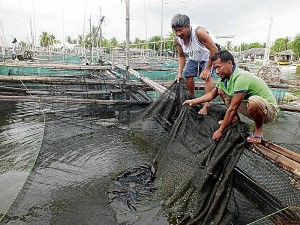
TEOFILO Quinto and Robert Lamsen help other fishermen by marketing their catch. Photo by Yolanda Sotelo, Inquirer Northern Luzon
DAGUPAN CITY—No one doubts that this Pangasinan city produces the best tasting bangus (milkfish) in the country.
But unknown to many, Dagupan is fast becoming a major producer of the expensive fish, lapu-lapu (grouper).
City agriculturist Emma Molina says there have always been lapu-lapu growers in the city but their production was on a limited scale.
“The number of growers and the production went up after the city’s rivers were cleared of fish pens that spawned pollution and which obstructed navigational lanes,” she says.
When the city government dismantled hundreds of fish pens, its operators and caretakers lost their livelihood, prompting the city government to offer them alternative sources of income.
“One of the livelihood activities we thought of was the raising lapu-lapu in cages, a venture that does not create as much pollution as raising bangus in pens. Lapu-lapu is an expensive fish,” Mayor Benjamin Lim says.
The rivers, which once teemed with pens, are now wide and clean waterways. Fish cages have been put up in areas near the banks of Pugaro and other island villages to culture lapu-lapu and other high-value fish like talakitok, malaga and sea bass.
Molina says Pantal River is a good area for lapu-lapu culture.
Teofilo Quinto, 43, a resident of the island village of Pugaro, used to own fish pens on which he cultured bangus. Last year, his fish pens were demolished as a part of the city government’s program to free the rivers of fishery structures.
It was good that he was culturing lapu-lapu on the side for many years.
“We asked Mayor Lim if we could continue to produce lapu-lapu and he agreed, even helping us in marketing our fish,” Quinto says.
From a single cage on which he started raising some 100 fingerlings, Quinto is now overseeing more than 10 cages that could stock more than 2,000 fish.
Fisherman Robert Lamsen, 46, finds lapu-lapu culture as a good source of income, prompting him to leave his job in a mining company in Benguet.
“I only own six cages but these are enough to provide for my family’s needs,” he says.
Lamsen says more than 200 fishermen here have shifted to lapu-lapu culture.
While they regularly supply a restaurant here with lapu-lapu, their bigger market is still Metro Manila, with traders from the metropolis coming here to buy their stock.
Quinto says fish cage owners had to consolidate their produce to meet the demand.
Lapu-lapu are cultured from five months to a year, depending on its size, Quinto says.
The best marketable size are lapu-lapu weighing 450 to 500 grams each. A kilogram of this size could fetch at least P450. The smaller lapu-lapu costs less, from P280 to P300 a kg.
Lapu-lapu eat what growers call “trash fish” or the small fish caught by trawls that could not be sold in the market.
In the past years, trawlers gave away the trash fish to lapu-lapu growers. But with many fishermen now into lapu-lapu culture, trawlers sell these at P15 to P20 a kg. Some 10 kg of trash fish are fed to 200 lapu-lapu every day, growers here say.
The lapu-lapu venture has also spawned another livelihood—fingerlings sale.
On the day the SundayBiz visited Pugaro’s production area, fisherman Francis Flores, 40, arrived with several newly caught lapu-lapu finglerlings that he would sell to Lamsen.
Flores used to sell his harvest in the local market, where the smallest (about three inches) are sold at P5 each.
“But we buy it at P15, so fishermen who gather fingerlings earn more,” Lamsen says.
The city has no hatchery for lapu-lapu and growers depend on fingerlings gathered from the wild for their stocks.
Fortunately, when the fish pens were demolished, local fishermen were able to harvest more fingerlings in the rivers, Molina says.


